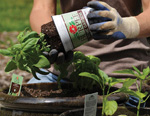Get active in your community garden
Burpee Edible Gardening Team Members

As America continues to “go green” – from the cars we drive to the homes we live in – our outdoor connection to the green environment becomes visible with fresh gardens. Urban areas especially benefit from community beautification in the landscape, and now success reaches far beyond. It’s not just about environmental activism anymore! Across the nation, city and community vegetable gardens are providing food and some well-deserved therapy.
When people come together to get their hands dirty, stronger neighborhoods are built and cleaner communities emerge. According the Charlie Nardozzi of the National Gardening Association, gardening is not just a "feel good" activity any more: “More and more city officials and community groups are recognizing that gardens reduce crime, increase citizen involvement, increase property values, empower residents to build stronger ties to their neighborhoods, and provide nutritious food in areas where it may not be readily available.”
Community Garden Recipe
Greening in the community often starts with a vacant lot and passionate neighbors. Add in a little help from local officials and/or some community groups, and soon an urban plot of land is transformed and filled with food, flowers, trees and shrubs.
“But what ultimately grows there extends beyond the transformation of one city lot,” says Nardozzi, who believes community gardens start a “domino effect” of positive actions in the wider community.
Get Involved
NGA encourages everyone to garden, and to get involved in the community garden process. Especially if you don’t have a green space of your own! There are plenty of resources available to help you get started. To find a community garden in your city or town, or learn how to start one, contact the American Community Gardening Association, at www.communitygarden.org. You can also check out National Gardening Association’s “Adopt a Community Garden Program” where you can lend support to a specific community garden in your area.
Want To Know More?
There's even a book available that underscores the successes of many community gardens and gives guidelines on how to participate and start one in your area. Community Gardening, by Ellen Kirby and Elizabeth Peters (Brooklyn Botanic Gardens, 2008), is the latest of the Brooklyn Botanic Garden guides. It features hands-on tips, including information on soils, water conservation, and plant selection. For community organizers, this book offers practical advice for starting a community garden and using it to build cohesion in a neighborhood. It profiles successful programs around the country and has a resource section for more information. Check it out! And share your community garden stories with us below.